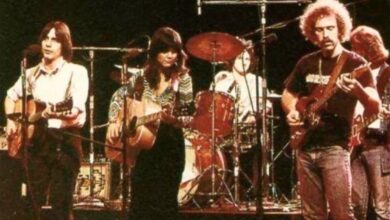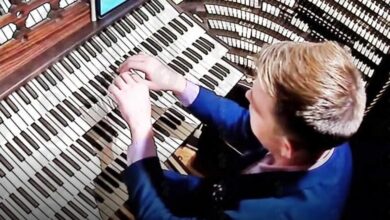The Bands of HM Royal Marines Breathe New Life and Emotion into “The Sound of Silence”
At London’s Royal Albert Hall, the Bands of His Majesty’s Royal Marines transformed “The Sound of Silence” into a luminous, collective experience that transcended its introspective origins. Their rendition glowed with emotional precision, turning one of modern music’s most contemplative songs into a shared expression of unity and grace. The night brimmed with elegance, each note breathing warmth into the vast hall as the audience listened in reverent stillness.
Performed as part of the Mountbatten Festival of Music, the piece carried a heritage of tradition and service. Since its inception in the 1970s, the festival has stood as a symbol of both artistry and altruism—merging the grandeur of military pageantry with humanitarian purpose. Each year, the event raises essential funds for naval and Royal Marines charities while celebrating musical excellence at the highest level.
The 2020 festival, held in early March, arrived just days before the global lockdowns would silence performance halls around the world. Positioned as the emotional centerpiece of the second act, “The Sound of Silence” provided a moment of reflection amid the pageantry. Its placement offered balance between the fanfares, film medleys, and marches—a contemplative breath that anchored the evening in humanity.
The performance’s emotional pull came from the pure, intertwined vocals of Band Lance Corporal Sam McIndoe and Musician George Gissing. Their voices blended seamlessly, filling the space with sincerity and poise. As they traded phrases, the harmony between them reflected not only musical precision but a sense of shared purpose, capturing the very essence of the song’s quiet strength.
Arranged by P. Trudgeon, the piece shimmered with reverence and grace. His orchestration added ceremonial weight without overpowering the song’s fragile introspection. Every phrase felt intentional, shaped with an ear for balance—honoring Simon & Garfunkel’s timeless message while giving it a distinctly regal texture befitting the Marine ensemble’s refined style.
Rather than dwelling in melancholy, the interpretation leaned toward uplift. It began with a delicate hush before gradually unfolding into a radiant wave of harmony. Even the quietest passages seemed to carry smiles between the notes, the musicians breathing as one. The ensemble’s dynamic control revealed a mastery born from discipline and mutual trust, where every swell carried emotional purpose.
The Royal Albert Hall itself became part of the music. Its fabled acoustics amplified each phrase, allowing soft lines to drift like whispers and crescendos to radiate like beams of light. The sound filled the hall without overwhelming it, creating the impression that every listener was inside the music rather than simply hearing it. The architecture seemed to resonate with the emotion of the song, adding to its sense of timelessness.
The Marines’ adaptability stood on full display. In one evening, they shifted effortlessly between bombastic brass fanfares and fragile vocal pieces, demonstrating the wide emotional range that defines their craft. That versatility—combining military precision with expressive freedom—became the heartbeat of the night, reminding the audience that discipline and creativity are not opposites but partners in artistry.
The charitable purpose behind the festival infused every performance with additional weight. Proceeds supported causes such as The Royal Marines Charity and CLIC Sargent, turning applause into tangible good. The musicians played not only for artistic fulfillment but for service, their music extending its reach far beyond the walls of the hall and into lives it would quietly touch.
The wider program sparkled with contrast—tributes to Tom Jones, cinematic scores, and the kind of sweeping orchestral numbers that define the festival’s flair. Against that lively backdrop, “The Sound of Silence” stood out like a still lake amid fireworks, a reminder that sometimes the quietest song speaks the loudest. Its simplicity became its greatest power.
The event also carried historical resonance, marking one of the final official public appearances of the Duke and Duchess of Sussex. Their presence added gravity to the evening’s significance, their standing ovation underscoring the shared respect that filled the hall. It was a royal gesture of appreciation that reflected the pride and emotion of everyone in attendance.
Behind the grandeur, teamwork remained the festival’s invisible foundation. From rehearsals to lighting cues, every detail spoke to a collective spirit of unity. That sense of togetherness radiated through the music itself—disciplined yet warm, formal yet profoundly human. Each player contributed to a seamless whole, embodying the very message of connection that “The Sound of Silence” conveys.
It’s easy to overlook that these musicians are also servicemen and women, trained for duties extending far beyond the concert platform. That dual role lends their performances emotional gravity: every note carries echoes of discipline, loyalty, and compassion. Their artistry becomes an extension of their service, proof that music and duty can coexist as two expressions of the same devotion.
When the performance later appeared online, it spread the magic of that evening far beyond the walls of the Royal Albert Hall. Through headphones and screens, audiences worldwide could feel the same radiance—the tender vocals, the soaring crescendos, and the serene unity of sound that only such a disciplined ensemble could achieve. Even in digital form, the warmth remained unmistakable.
In the end, this version of “The Sound of Silence” glowed not because of spectacle but because of sincerity. It lived in the breaths between phrases, the glances between performers, and the invisible thread connecting every listener. That is the enduring gift of the Bands of His Majesty’s Royal Marines: their ability to transform grandeur into intimacy and silence into music that lingers long after the final note fades.





